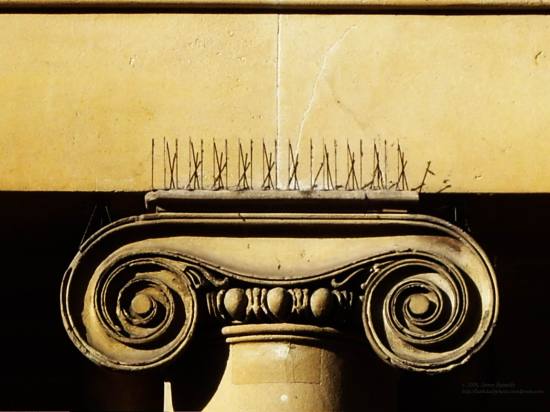061114.Bathwick, Architectural Pigtails
November 14, 2006 at 12:49 AM | Posted in Architecture, Bath, Bathwick, Cathedrals and churches, Chisel Marks, Columns, doorways, Ionic Order, somerset | 3 Comments
This is a Greek Ionic capital and full architrave on the southeast façade of T. Baldwin’s 1789 Argyle (United Reformed) Church was actually created by H. Goodridge. It is opposite, and is clearly the inspiration for yesterday’s Chemist’s Greek Ionic ordered shopfront, and marks the Greek Revival style’s presence in late 18th Century Bath. (Cheers to Alex of Boston DP for naming it yesterday)
Also, it’s sunny.
I’ll post a Roman Ionic tomorrow so I figure I should explain this Order, in case anyone is unaware of its full potential and secret magical powers.
Out of all the Orders, the Ionic capital is most easily identified because of its clear volutes. The only confusing categories are Greek and Roman Ionic capitals. This capital is Greek with only two volutes, or scrolls, on either end, while the Romans diagonally placed the volutes on each of the four corners to allow for the column to be placed in rotundas or on corners (Greek Ionics need flanking pilasters because you can’t have a long volute end a colonnade). Ionic Orders typically flute their columns, although clearly not this Baldwin example (the architrave picture isn’t a great Ionic example either).
One last technical issue with the Ionics and then I’ll shut up about the history, unfortunately this is a whopper. Classical column Orders are used to proportion building facades, etc. You know this, I know, bear with me a moment. Since Ancient times the formula for creating a correct Ionic column has been to take the diameter of the column at its base and multiply that by nine. (Hope I don’t get assassinated by the Masons for telling you this!) Occasionally, you will see the number used in this formula as eight, but that’s from the Renaissance when they were just rediscovering everything and things vary.
But enough of architectural history: onto myths, legends, and gender theory!
“Ionic” should clue you in to where it originated from in Greece. It originated in the mid 6th Century BC, shortly after the Doric Order and as a fancier version. It is therefore ranked above that order in the column hierarchy. Its defining volutes are sometimes referred to as scrolls, which aptly represents the Greek culture they originated out of—namely Athens. The Doric Order region’s principal city was Sparta, which valued the spears over scrolls and subsequently won the Peloponnesian War (431-404 BC).
Thus the Doric Order’s sturdy/stocky frame (its diameter to height proportions are only 1:8 or sometimes 1:7) is associated with the male body’s proportions and the essence of manliness. This Order frequently appears adorning the façades of barracks, headquarters, or any building seeking to prove something.
In contrast, legend states that the Ionic Order’s volutes, which can be seen as scrolls, were modeled after the curled locks of a young girl’s hair. Therefore the entire Order represents the more graceful female body proportions and feminine virtue, itself. Unsurprisingly, it often appropriately adorns hospital facades, etc..
One notable exception in New York City is the Central Park-facing façade of the American Museum of Natural History. Built in honor of President Theodore Roosevelt who had been born there and shot most of the animals the museum displayed, the architect associated the Ionic Order with intellect after perceiving the volutes to be scrolls. He then deliberately combined the capitals with unfluted stocky Doro-Tuscan columns (1:7) to emphasize the adventurer president’s respected learning and physical strength. (This theme is repeated on museum murals inside with the former president riding at the Battle of San Juan Hill and negotiating the peace treaty that ended the Russo-Japanese War.) However, if you click on the link above, you’ll notive that unlike my Bathwick example, not only is the architrave correct for the Greek Ionic Order, but also the NYC architect gets the entire entablature spot on with its flat frieze and dental cornice. The proper entablature is also present on yesterday’s Chemist’s porch.
So maybe you learned something? Look back at the capital with volutes and imagine it on a girl today; not a pretty picture, is it? Since Classical architecture is everywhere, take out a tape measure and test this to discern whether your local architect had been initiated into the secrets of the Ancient World. Keep in mind if the measurements don’t work out that perhaps the architect was trying to communicate to an Order-literate public that something was deliberately amiss in the building.
Tune in tomorrow for the next exciting Ionic update!
Create a free website or blog at WordPress.com.
Entries and comments feeds.

